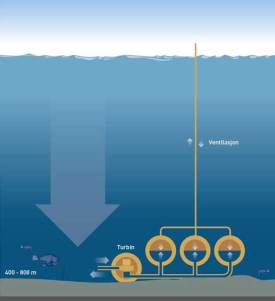Storing energy at seabed as efficient as current energy storage plants
 The idea where energy is stored at the bottom of the sea has been around for a while, and a group of Norwegian researchers decided to contribute to realization of that concept. In cooperation with researchers at SINTEF who develop the tanks employed by this method, they plan to use their patent pending technology to store electricity by exploiting the high water pressure at the seabed.
The idea where energy is stored at the bottom of the sea has been around for a while, and a group of Norwegian researchers decided to contribute to realization of that concept. In cooperation with researchers at SINTEF who develop the tanks employed by this method, they plan to use their patent pending technology to store electricity by exploiting the high water pressure at the seabed.
“A pumped storage power plant is a hydroelectric plant which can be “charged” up again by pumping the water back to the upper reservoir once it has passed through a turbine. This type of power plant is used as a “battery”, when connected to the power grid”, said Rainer Schramm, inventor and founder of the company Subhydro AS to Gemini.no.
To use the water pressure at the sea bed in practice, the mechanical energy is converted by a reversible pump turbine, as in a normal pumped storage hydroelectric plant. In this pumped storage power plant turbine will be connected to a tank on the seabed at a depth of 400 to 800 meters (1312.34 to 2624.67 feet). The turbine is fitted with a valve, and when the valve is opened, water flows in and starts turning the turbine. The turbine drives a generator to produce electricity.
When the water tanks are full, the water must be removed from the tanks. This is achieved by running the turbine in reverse, so that it functions as a pump. Although a bit more energy from the power grid is used to empty the water tanks than can be recovered from flooding them, the degree of efficiency of this type of power plant is as high as current conventional energy storage plants. According to Schramm, calculations indicate an electric storage efficiency of approximately 80 percent round-trip.
“We envisage that this type of storage plant will function well in conjunction with, for example, wind farms. At strong wind conditions, excess electricity is sent sub-sea to pump water out of the storage tanks. In periods with little wind, energy can be obtained from this underwater plant instead. The same applies to solar generation: the pumped storage power station can contribute to constant electricity production at night time when there is no sunshine to run a solar power plant”, said Rainer Schramm.
Aside the number of used tanks, the sea depth also determines the effectiveness of the plant. The deeper the system is placed the greater is the pressure difference between the sea surface and the seabed, thus allowing more energy to be stored in a single tank.
One of the challenges SINTEF researchers are solving is related to development of a material suitable for these tanks. Their goal is to develop a type of concrete which can be used to cast the water tanks which are placed on the seabed.
“The challenge is to find the optimal balance between strength and cost. If we achieve the goal of creating a concrete which will withstand at least 5 times as high loading as ordinary concrete, we can reduce the wall thickness by 75 percent. This is a critical factor. We need to reach production and installation costs which make storage of energy economical in relation to the price of electrical energy”, said Tor Arne Martius-Hammer, SINTEF Building and Infrastructure expert on strong and light concrete types. “One of the solutions SINTEF will work on is reinforcing the concrete with thin steel fibers instead of the normal steel rebar. This will result in a significant simplification of the production process. Concrete is in existence at present which can be used, but our job is to develop a cheaper alternative.”










Leave your response!